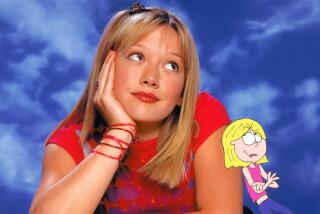Teens Flow to ‘Creek’
If you have a teenage daughter watching television at 9 o’clock tonight, chances are better than one in three that she’s tuning in “Dawson’s Creek”--a new drama series that has prompted, and apparently benefited from, second-guessing as to the propriety of its dialogue and story lines.
Premiering just six weeks ago, “Dawson’s Creek” has been a major hit by the modest standards of the WB network, almost instantly becoming network television’s No. 1 show among female teens.
The show has also rekindled debate over the sexual messages television sends to kids, who, according to a recent panel co-sponsored by the WB network and the nonprofit Media Project, draw considerable input on such issues from the media.
Created by Kevin Williamson, who wrote the “Scream” movies and “I Know What You Did Last Summer,” the semiautobiographical series focuses on four 15-year-old kids growing up in a small Massachusetts coastal town.
At its core is a triangle involving aspiring filmmaker Dawson (James Van Der Beek), longtime friend Joey (Katie Holmes) and a new girl, Jennifer (Michelle Williams), who complicates Dawson and Joey’s platonic but increasingly awkward relationship. The teens speak like Harvard-educated adults while frankly discussing topics that include sex and masturbation.
Most problematic to some, however, has been a story involving Dawson’s friend Pacey (Joshua Jackson), whose affair with his 36-year-old English teacher was resolved last week when word of the liaison spread and the teacher chose to leave town.
“Dawson’s” precocious teens (Pacey told the then-reluctant teacher he would be “the best sex you never had”) and those on similar programs help feed “cultural attitudes on these [sexual] issues that are divorced from human reality,” said Dr. Drew Pinsky, who offers counseling to teens and young adults on the program “Loveline,” which airs on MTV and KROQ-FM.
Pinsky added that it is “extremely destructive psychologically” to have an authority figure depicted in a sexual way, as was done in the teacher-student relationship.
WB officials say they did not seek to stoke controversy surrounding the show, though they acknowledge it has probably helped spur interest. They also point to real-life precedent for such relationships, citing the recent case of Seattle teacher Mary Kay LaTourneau.
“Do I feel we’ve acted responsibly? Absolutely,” said WB chief executive Jamie Kellner. “I don’t think there’s anything in this program we haven’t seen in the news or the movies, and we feel we did it in a responsible way.”
Kellner stressed that the program is also drawing an adult audience, especially in markets such as Los Angeles, where WB--which operates on weak UHF stations in much of the country--is seen on a strong independent station, KTLA-TV Channel 5. Local ratings nearly double what the series is averaging nationally.
Still, even in Los Angeles the driving force behind the show’s success has been teenage girls and, to a lesser extent, women in the 18-34 age range.
“It’s definitely a chick show,” said Laurie Chacanaca, 17, a student at Saugus High School, who said the program is “realistic, but also has some fantasy too.”
More than 2 million teens (in television parlance, teens encompasses ages 12 to 17) tune in on a weekly basis nationwide, according to Nielsen Media Research. While the audience includes a relatively small percentage of children younger than 12, they still number about 900,000 each week, meaning roughly 40% of the show’s audience is under 18.
Mollyanne Brodie, a senior researcher at the Henry J. Kaiser Family Foundation, said at the Media Project panel that parents remain children’s primary source of information about sexuality in their early years, calling the period from age 8 to 12 “a critical window to establish open lines of communication.”
She added, however, that few parents initiate such discussions, and that peers and the media surpass parental authority as a source of information as children move into their teens. In a 1996 foundation survey, more than half of teens said they learn at least some information about sex and birth control from television and movies.
With its attractive cast and adult dialogue, “Dawson’s Creek” has clearly created a beguiling picture of teen life.
“We wanted our kids to be really articulate and very good at expressing themselves, [while they] grapple with the same problems and sense of confusion that other teens are dealing with,” said Paul Stupin, one of the program’s executive producers.
As for the teacher-student plot, Stupin said the story represented an effort to keep the series unpredictable and that Pacey was clearly shown to be “in way over his head, in a relationship he shouldn’t be having.”
The program’s young fans, meanwhile, dismissed concerns about its content.
Sari Berman, also 17 and a Saugus classmate of Chacanaca, said she was drawn to the show in part by the controversy “to see what’s the big deal.” Berman said she feels the criticism is “way out of proportion. I think it’s fine, especially for a 9 o’clock time slot.”
As for its preoccupation with sex, she added, “I know with my friends, you really can’t go through a day without something coming up about [sex] or relationships.”
Even younger teens say the program’s blunt and frequent talk about sex doesn’t disturb them.
“It doesn’t really bug me that much, because I go to public school, so you can hear that stuff every day,” said Erin Voss, 13, who attends El Rancho Middle School in Anaheim Hills.
“Dawson’s Creek” already has been renewed for next season, along with its Tuesday running mate, “Buffy the Vampire Slayer,” and the softer family drama “7th Heaven.” By building its profile among teens, WB is emulating the formula employed by Fox, which initially brought teens to the network with shows such as “Beverly Hills, 90210” and “In Living Color” before gradually expanding its adult audience.
“I think teens are in many ways the leaders of pop culture in our country. They embraced Fox in its infancy,” said Kellner, who was at Fox when that network launched. Kellner added that the network will begin running more public-service announcements aimed at teenagers, though he would not specify what ads would be shown within “Dawson’s Creek.”
Advocates such as Pinsky say television does have a role to play in helping educate youths about sexual responsibility. With ongoing debate over sex education in schools, the media, he said, “needs to step up and fill in where government bogs down.”
Saugus High’s Berman, meanwhile, objects to television being called to task for society’s problems.
“The [notion] of TV running people’s lives angers me,” she said. “People have to think for themselves.”
More to Read
The complete guide to home viewing
Get Screen Gab for everything about the TV shows and streaming movies everyone’s talking about.
You may occasionally receive promotional content from the Los Angeles Times.






